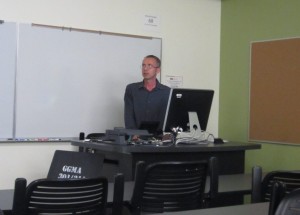April 9, 2013
 Pop quiz question—how much of the earth’s surface is covered in water? The answer is 70%. Although that is a big number, less than 1 percent of that water is actually suitable for human use and consumption. The majority of the water on Earth is full of salt or permanently frozen in glaciers. With large scale usage of clean water for farming, drinking, and washing, the concern of water scarcity and drought comes to mind. Researchers have turned to developing water desalination as a route to protect clean water for the future. If we are able to successfully tackle water-related challenges by desalination, then we could ultimately face the looming effects of climate change and clean water demands for the future.
Pop quiz question—how much of the earth’s surface is covered in water? The answer is 70%. Although that is a big number, less than 1 percent of that water is actually suitable for human use and consumption. The majority of the water on Earth is full of salt or permanently frozen in glaciers. With large scale usage of clean water for farming, drinking, and washing, the concern of water scarcity and drought comes to mind. Researchers have turned to developing water desalination as a route to protect clean water for the future. If we are able to successfully tackle water-related challenges by desalination, then we could ultimately face the looming effects of climate change and clean water demands for the future.
On March 18, 2013 the ASU Energy Club hosted an event focused specifically on the development and energy impact of water desalination plants as part of their Water-Energy Nexus Workshop series.
The guest speaker for this event was Dr. Jesus Gastelum from the Yuma Desalting Plant (YDP), a water treatment facility. Gastelum first gave the ASU Energy Club an overview of the Colorado River Basin. The Colorado River Basin provides water to Colorado, Utah, Arizona, Nevada, California, and Mexico. Water from the Colorado River Basin is delivered to Arizona via the Central Arizona Project (CAP) canal which provides Arizona municipal, agricultural, and Indian communities with water. It is a 336-mile long system starting from Lake Havasu City all the way to San Xavier Indian Reservation in Tucson. The system is comprised of aqueducts, tunnels, pumping plants and pipelines that provide a steady source of water to the people of Arizona. The Navajo Generating Station (NGS) provides the electrical power needed to pump water into the CAP aqueduct. The relationship between NGS and CAP is an example of a water-energy nexus because together they determine how much energy it takes to keep a consistent flow of water in the canal.
Water will always remain in high demand for Arizona due to our desert acclimated environment. It certainly does not help that both climate change and population demand has contributed to the greater possibility for drought for the southwestern portion of the United States. The 2007 and 2010 summer drought serves as examples of times when water shortages have hit Arizona hard. The CAP states that the Colorado River will never completely dry up, but they do note the capability for drought. Although they have guidelines for drought preparations and “enough water stored behind dams to provide the needs for upper and lower basin states for three to five years”, projects like the YDP and other water desalination plants have been initiated to further prevention. The YDP was built in 1992 as a project to help the U.S. ration the water from the Colorado River by demonstrating desalination as the potential answer for the growing thirst of southwestern states.
YDP focuses on cleaning up inland brackish water, both surface and groundwater, and includes analyzing water samples from the Colorado River. YDP uses the process of pretreatment and reverse osmosis (RO) to clean water and make it suitable for human use. YDP is looking into treatment alternatives that could potentially limit the amount of chemicals used in water treatment. Gastelum said that YDP’s purpose is to “Ensure tomorrow’s water supply by pioneering new technologies”.
It takes an extreme amount of energy to run water plants. For example, YDP uses over 33,000 megawatts and CAP uses 2.8 million megawatts of power to operate their plant. ASU Energy Club members were interested in discussing the possibility of solar to operate water plants in the future. They gave the example of the city of Gila Bend which powers their RO water system with a 460 kilowatt photovoltaic solar-energy system. Although a great use of energy efficiency for Gila Bend, using solar to entirely power YDP and CAP could prove to be fairly difficult. What is difficult now, however, may not be in the near future. With further research and development in solar power, water desalination plants like YDP could be a source of sustainable and energy efficient water for our future.
Researchers at ASU are working hard to confront challenges with water in our desert environment by studying the effects of climate change, available access to water, the possibilities of wast ewater,and more. Check out ASU’s water research homepage here.
Written by Gabrielle Olson, ASU LightWorks
Photo taken by Gabrielle Olson, ASU LightWorks
Additional Information:
http://ga.water.usgs.gov/edu/drinkseawater.html

